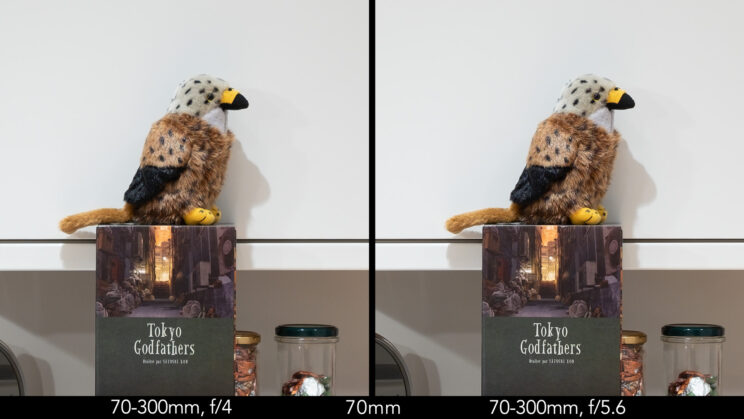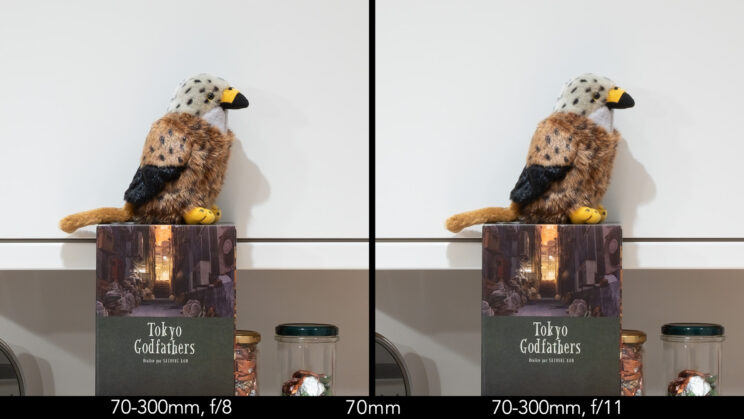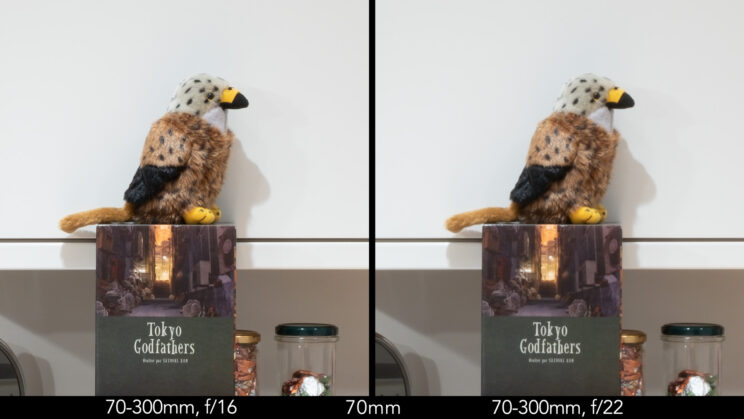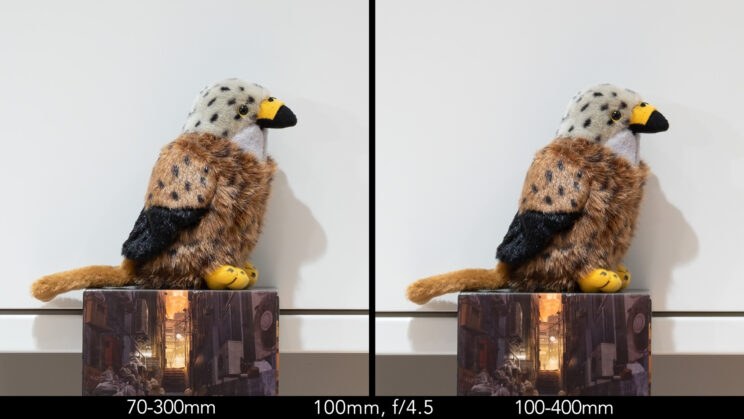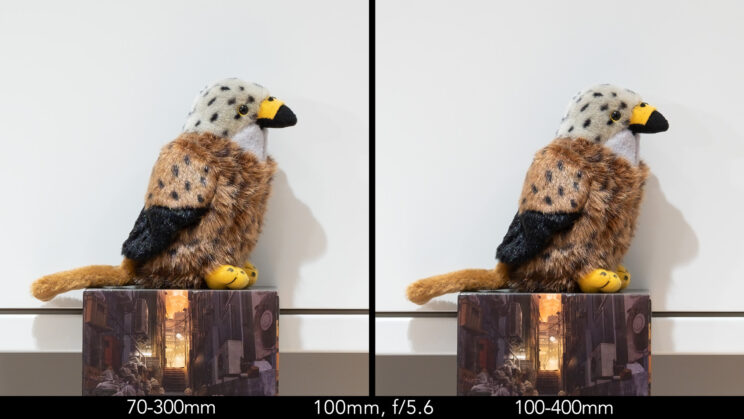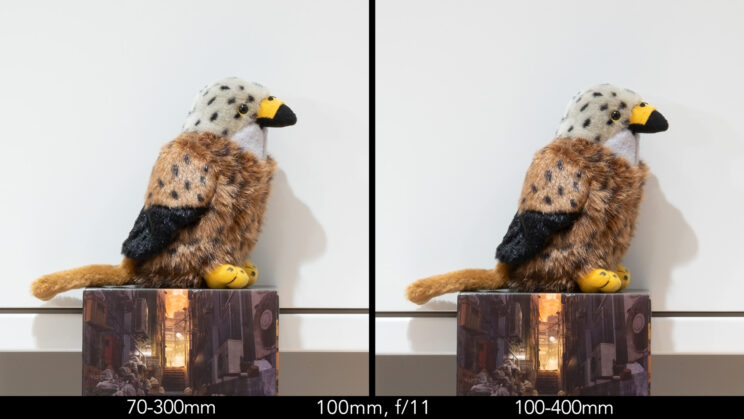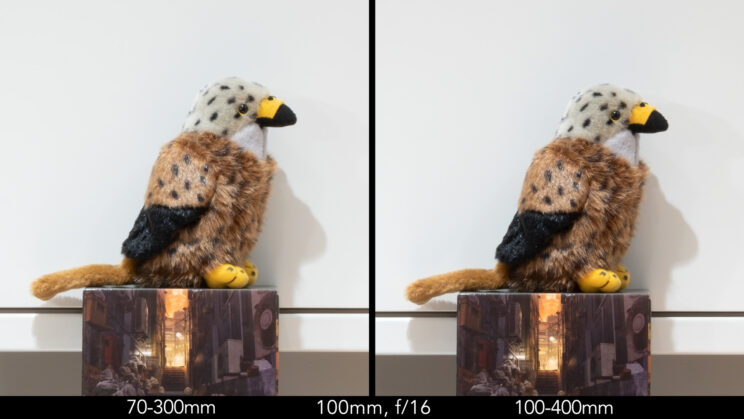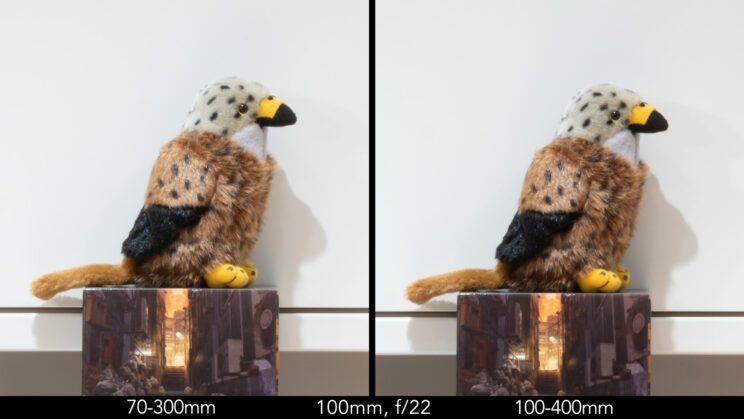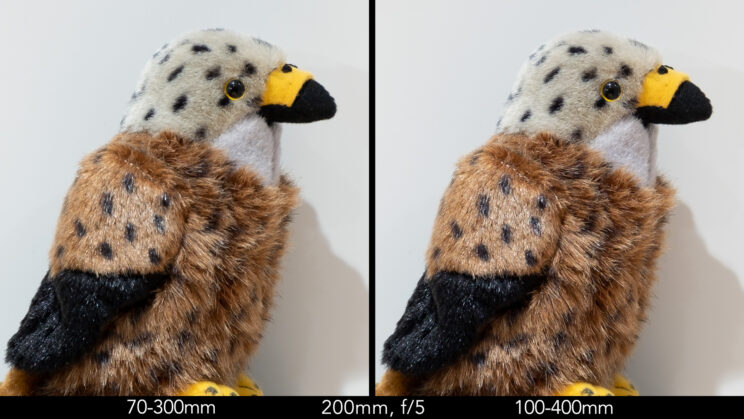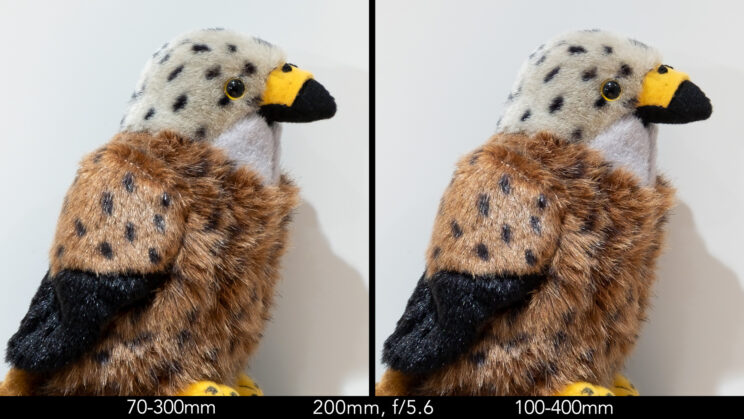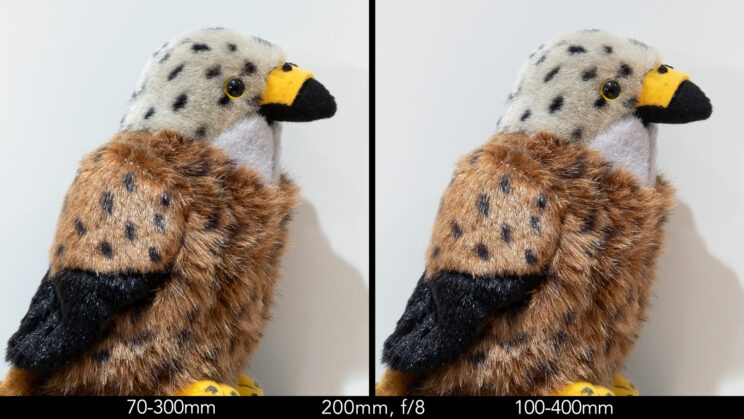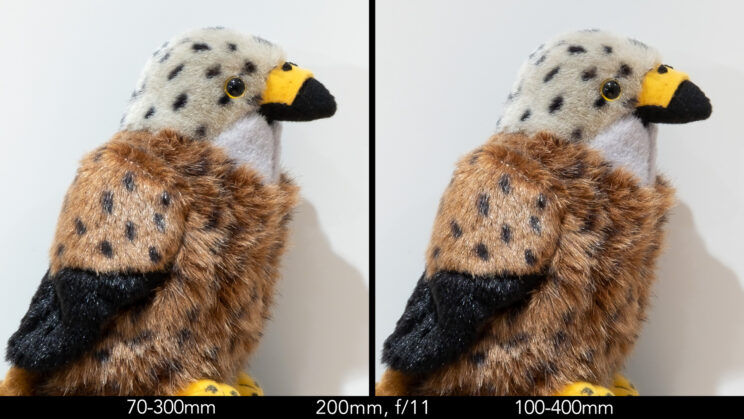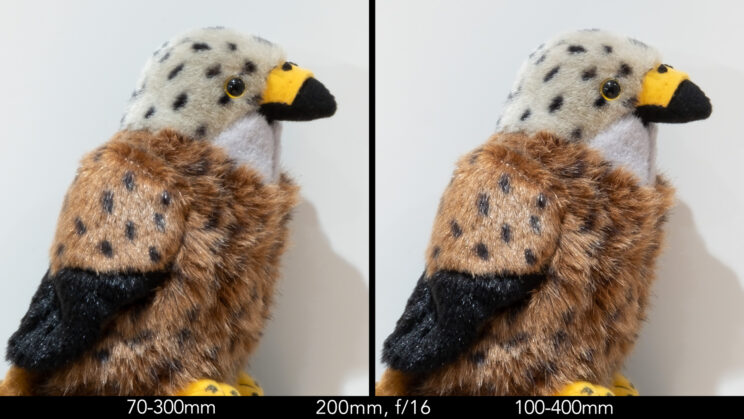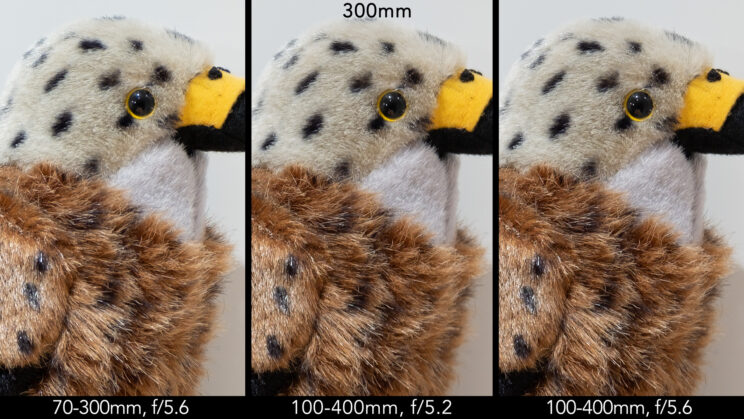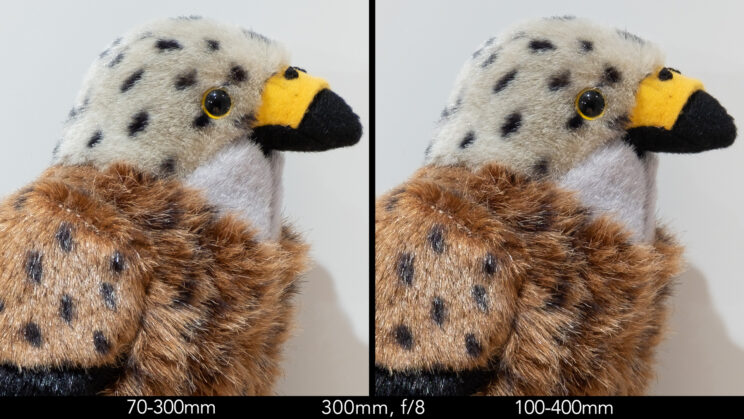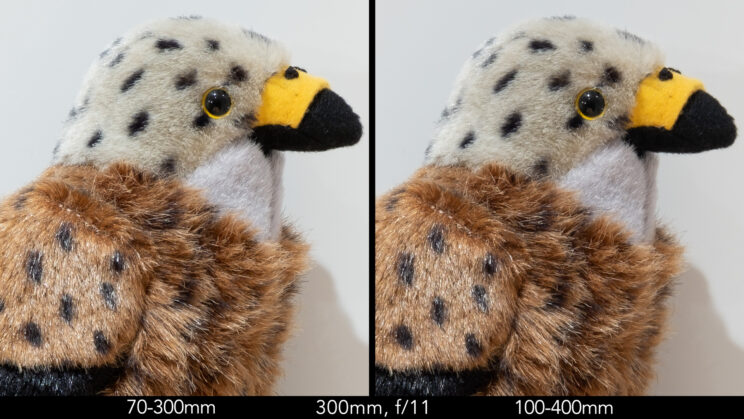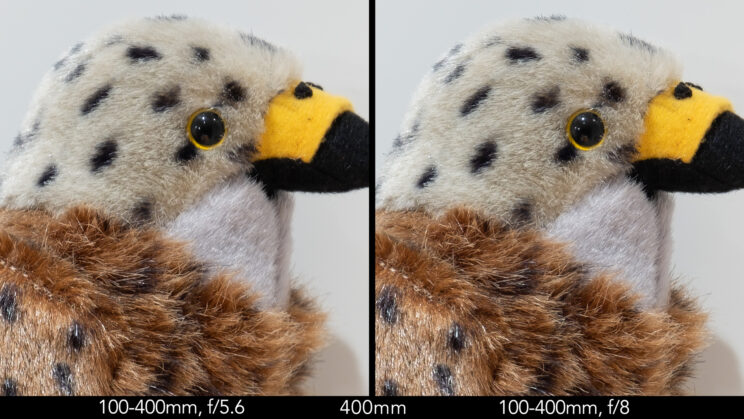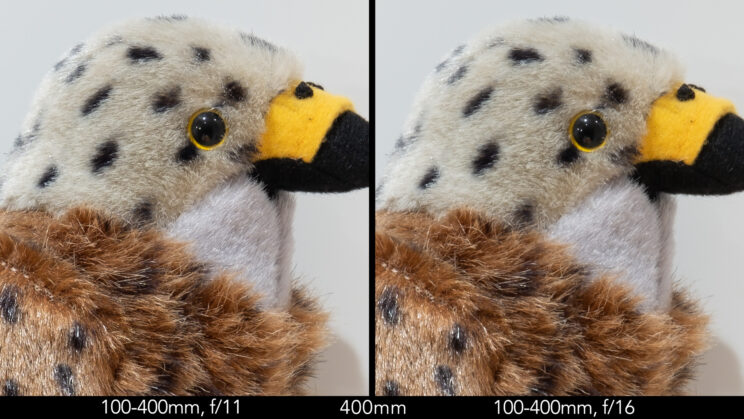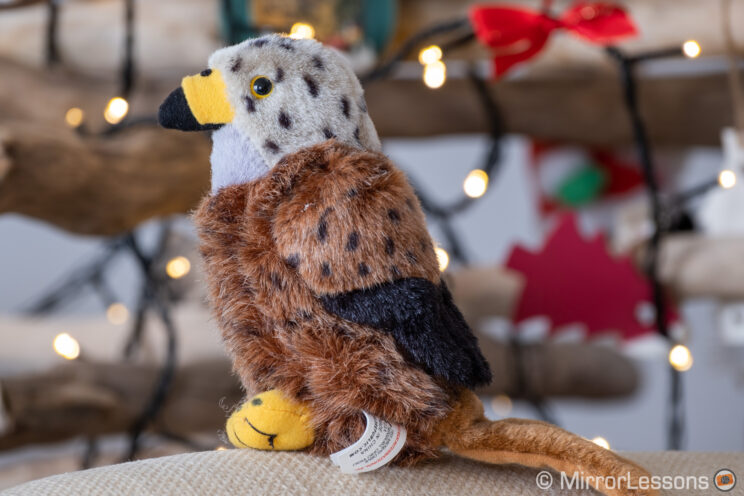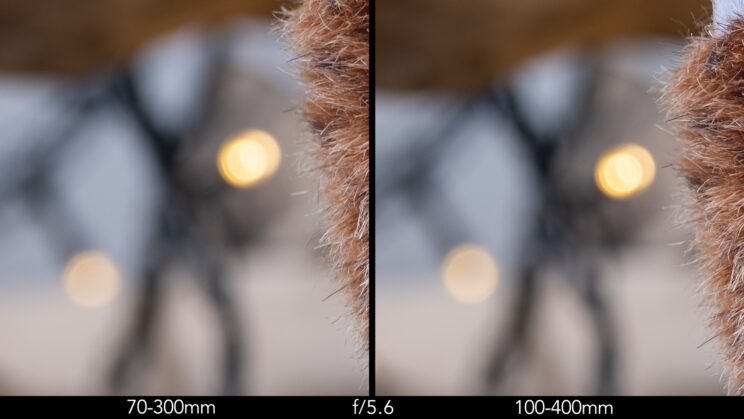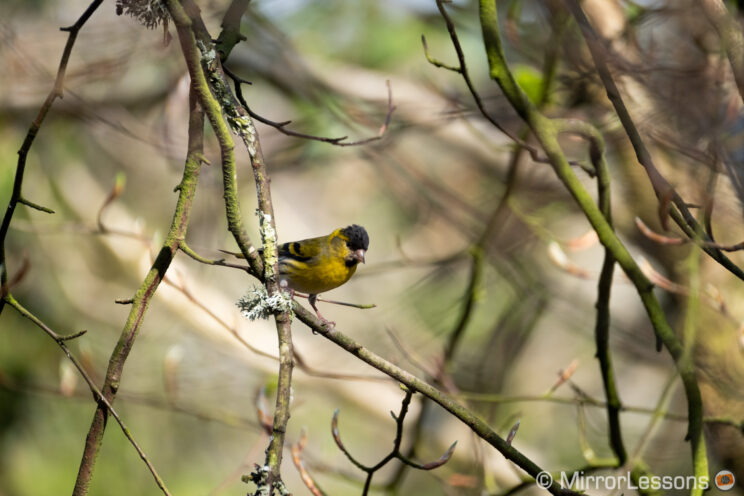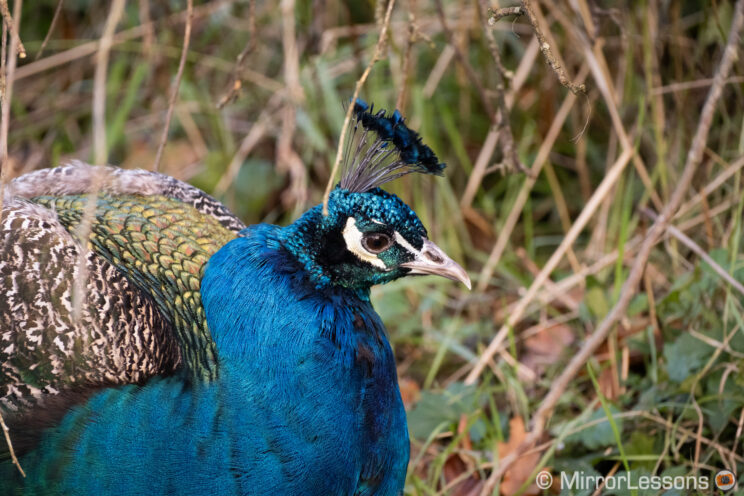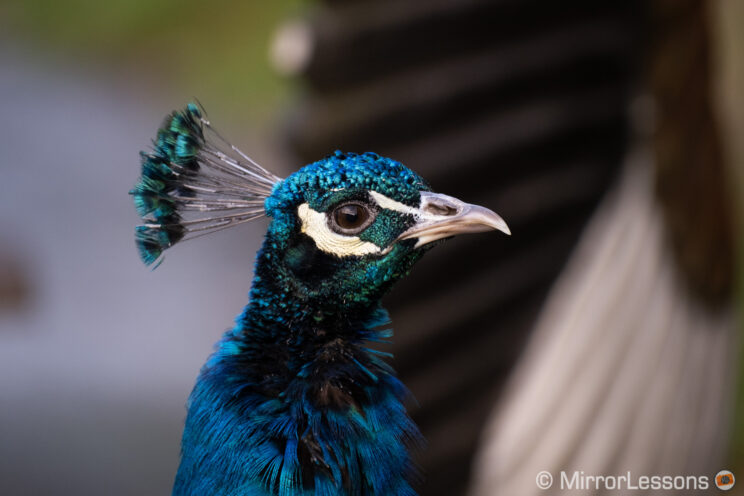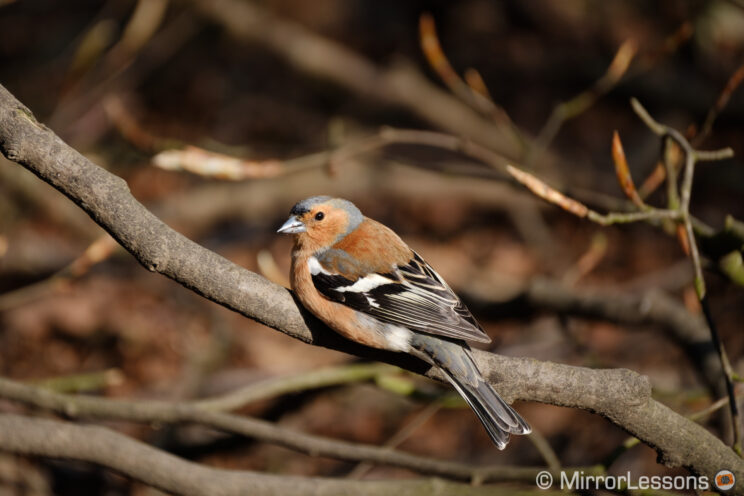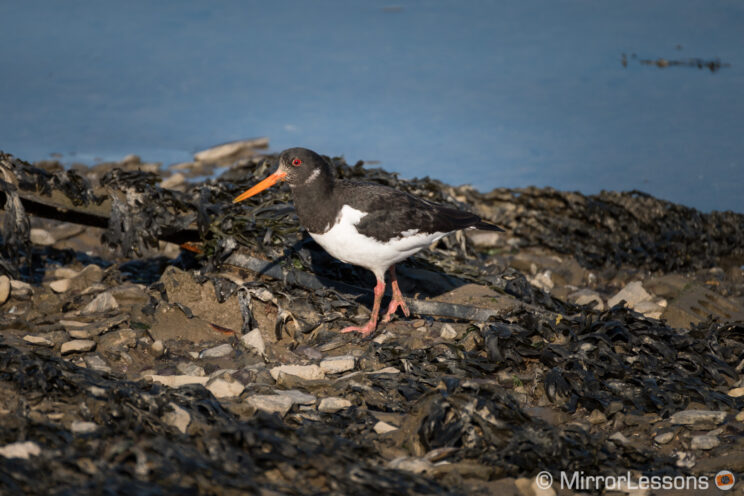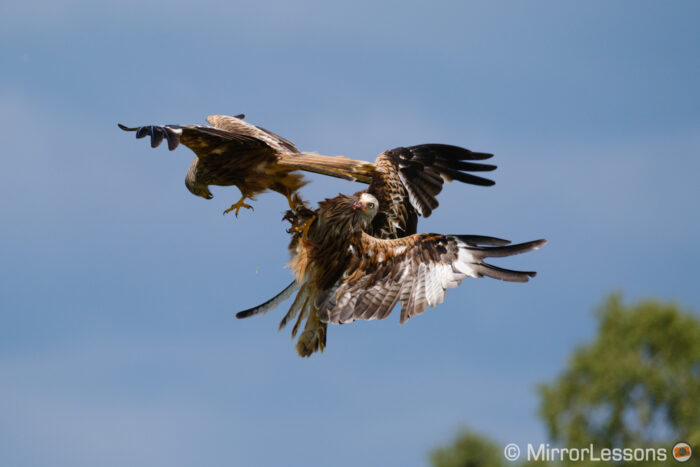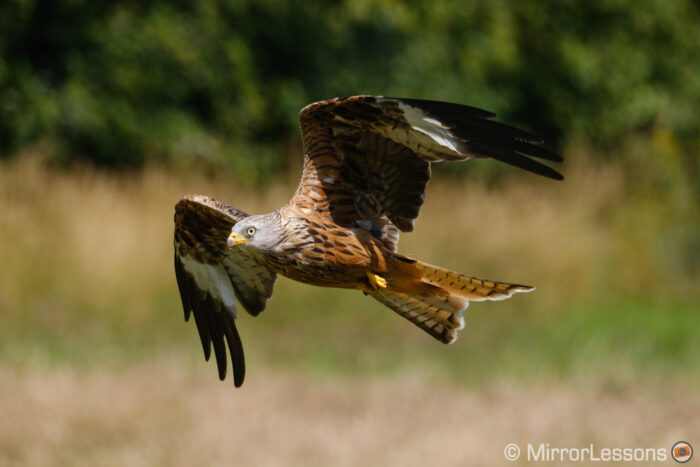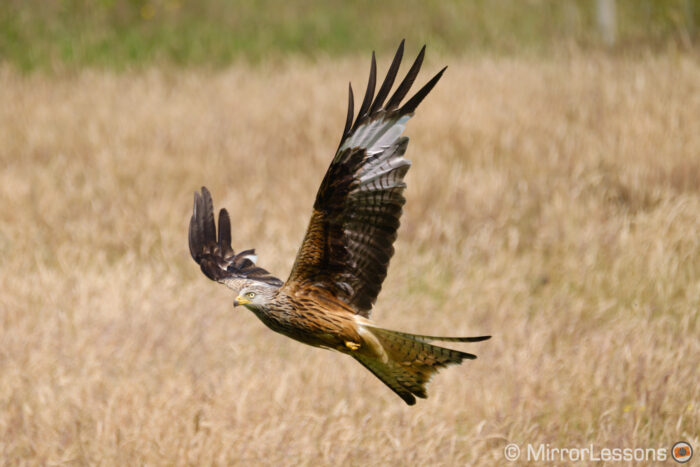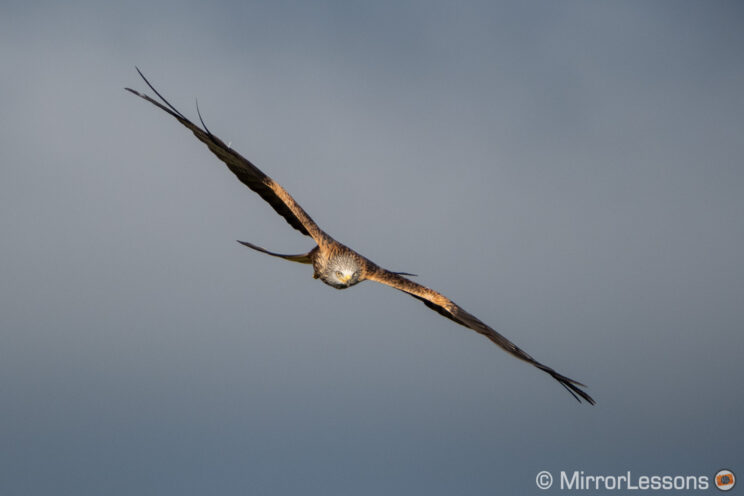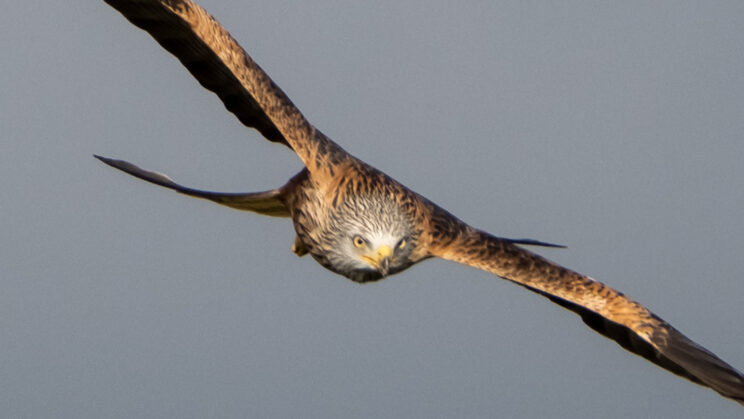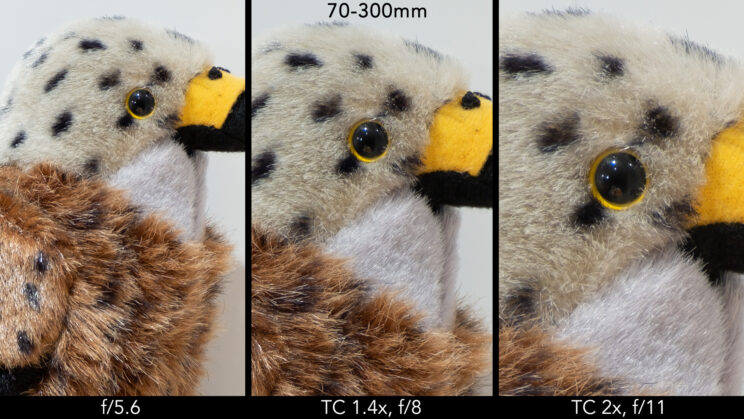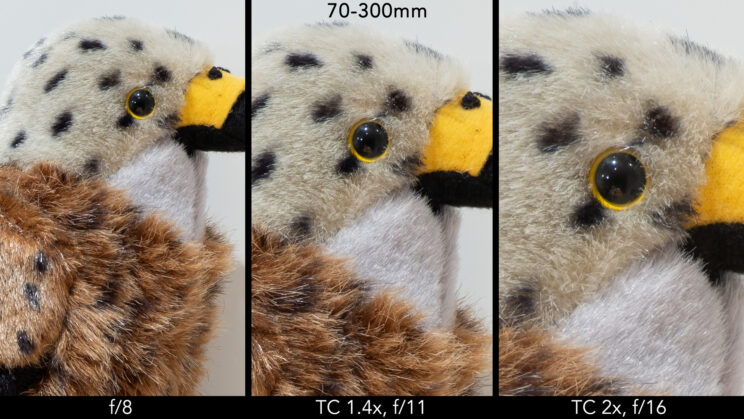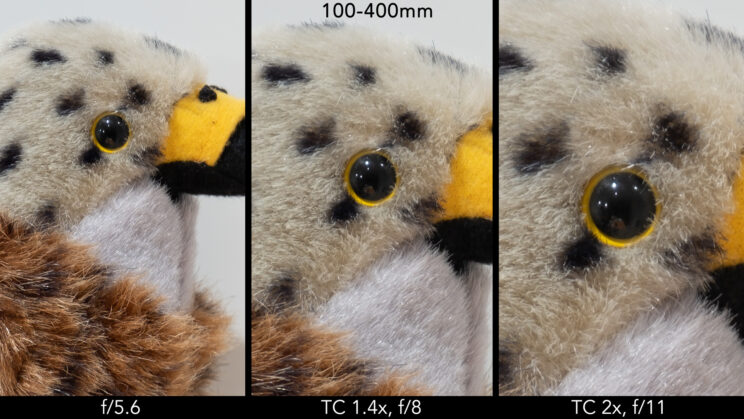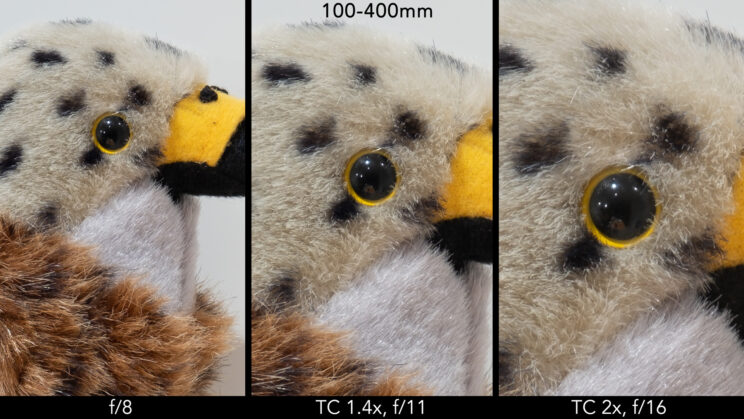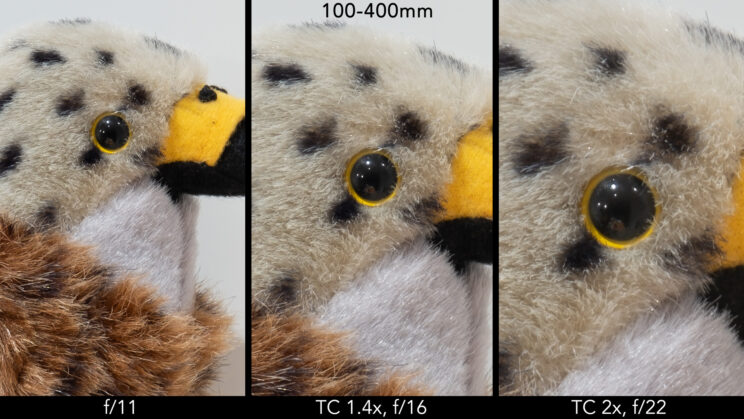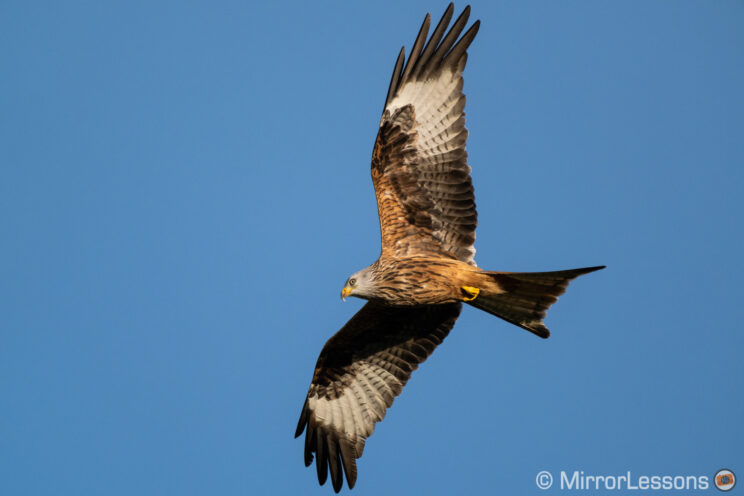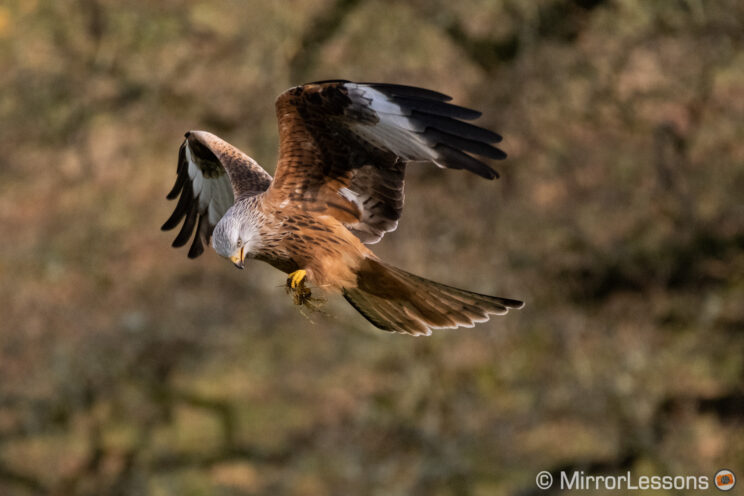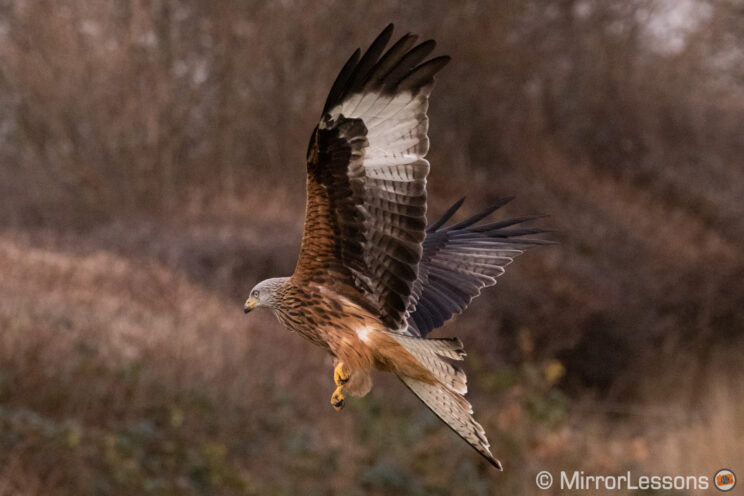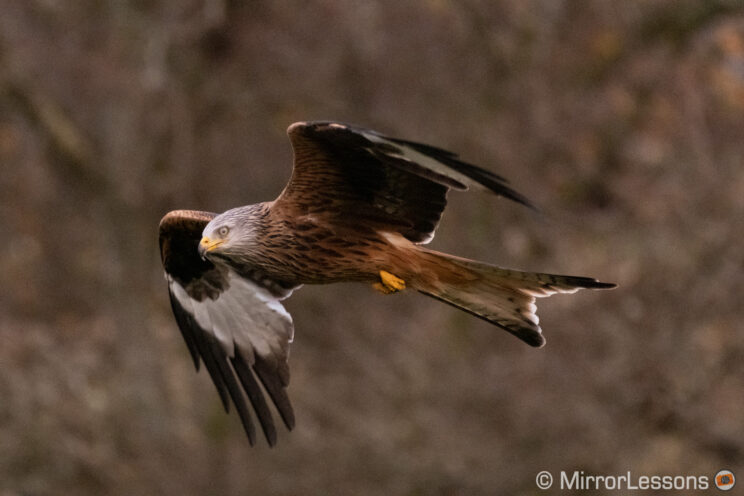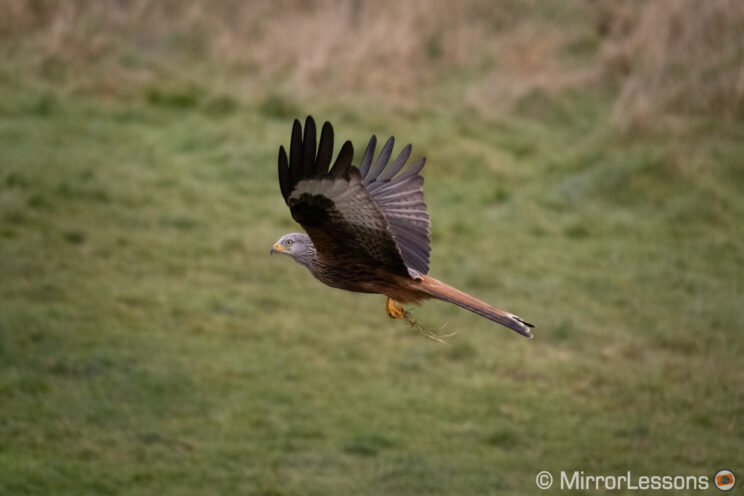Fujifilm isn’t necessarily the first brand that comes to mind for wildlife and bird photography, yet it is the only APS-C mirrorless system (alongside Sony) to offer lenses with a long zoom range such as the 100-400mm.
In early 2021, the manufacturer released a new product, the 70-300mm, that is interesting for various reasons: it is smaller, less expensive but still works with the two teleconverters, giving photographers the possibility of a long reach on a budget.
Naturally, I was curious to compare the two lenses and see what differences I could find. Read on to see how they perform side by side.
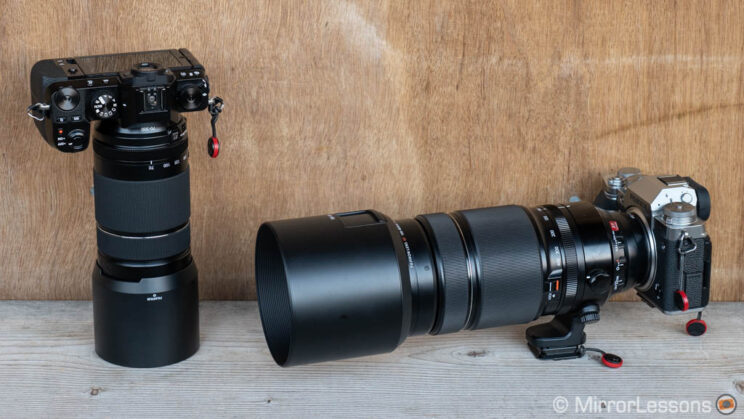
Ethics statement: we rented the two Fujifilm lenses, as well as the X-S10, for two weeks. We own the X-T4. We were not asked to write anything about these products, nor were we provided with any sort of compensation. Within the article, there are affiliate links. If you buy something after clicking the link, we will receive a small commission. To know more about our ethics, you can visit our full disclosure page. Thank you!
Table of Contents
1. Main Specs
2. Design and Ease of Use
3. Field of View and Aperture
4. Optical Quality
5. Autofocus and Manual Focus
6. Optical Stabilisation
7. Teleconverters
8. Prices
9. About the Cameras
10. Conclusion
Main Specifications
XF 70-300mm F4-5.6 R LM OIS WR
- Mount: X-mount
- Format coverage: APS-C
- Focal length: 70-300mm
- 35mm format equivalent: 105-450mm
- Weather sealing: Yes
- Maximum aperture: 4.0 (W) – 5.6 (T)
- Minimum aperture: 22
- Number of aperture blades: 9
- Angle of view: 22.9° – 5.4°
- Closest focusing distance: 83cm
- Maximum image magnification: 0.33x
- Lens configuration: 17 elements / 12 groups
- Special elements: 1 Aspherical, 2 ED elements
- Lens surface coating: Yes
- Optical stabilisation: Yes
- Dimensions: ø75mm x 132.5mm (205.5mm when extended)
- Filter diameter: ø67mm
- Weight: 580g
XF 100-400mm F4.5-5.6 R LM OIS WR
- Mount: X-mount
- Format coverage: APS-C
- Focal length: 100-400mm
- 35mm format equivalent: 150-600mm
- Weather sealing: Yes
- Maximum aperture: 4.5 (W) – 5.6 (T)
- Minimum aperture: 22
- Number of aperture blades: 9
- Angle of view: 16.2° – 4.1°
- Closest focusing distance: 1.75m
- Maximum image magnification: 0.19x
- Lens configuration: 21 elements / 14 groups
- Special elements: 1 Super ED, 5 ED elements
- Lens surface coating: Yes
- Optical stabilisation: Yes
- Dimensions: ø94.8mm x 210.5mm (270mm when extended)
- Filter diameter: ø77mm
- Weight: 1375g
Design and Ease of Use
The photos below say it all: the 70-300mm is much smaller, and its weight is less than half that of the 100-400mm. The zoom mechanism is not internal so both lenses extend when narrowing the field of view.
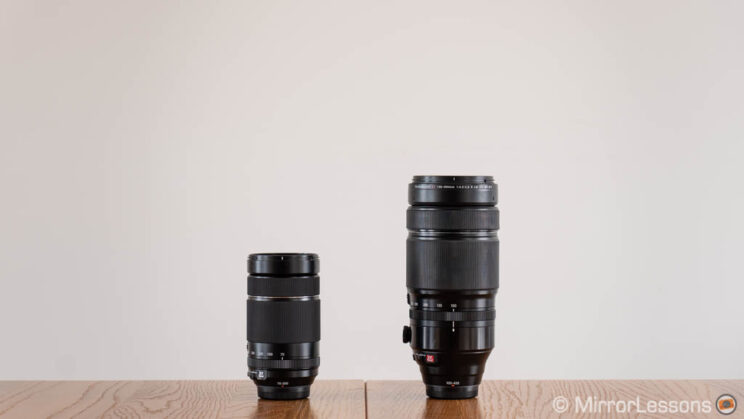
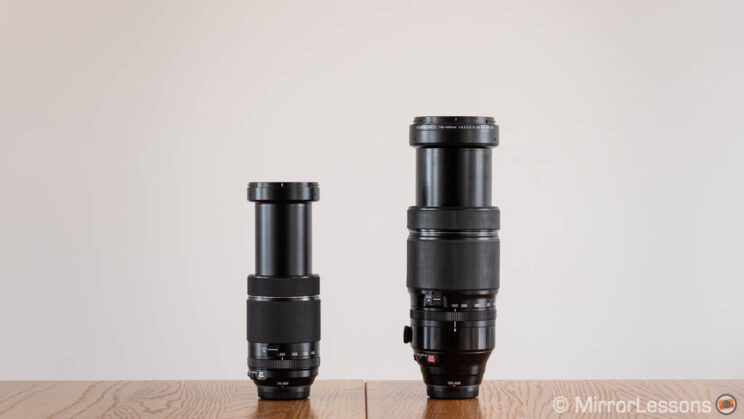
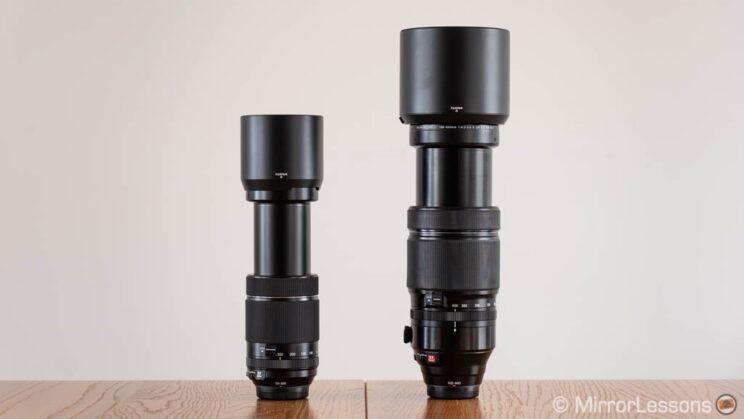
The two products are weather sealed but the 70-300mm barrel is mainly made of high-grade plastics to keep the weight down, which inevitably gives you the feeling of a less premium product.
The 100-400mm feels stronger when it comes to the build quality, although it too has plastic parts. It also features fluorine coating on the front element to make it more water repellent and easier to clean.
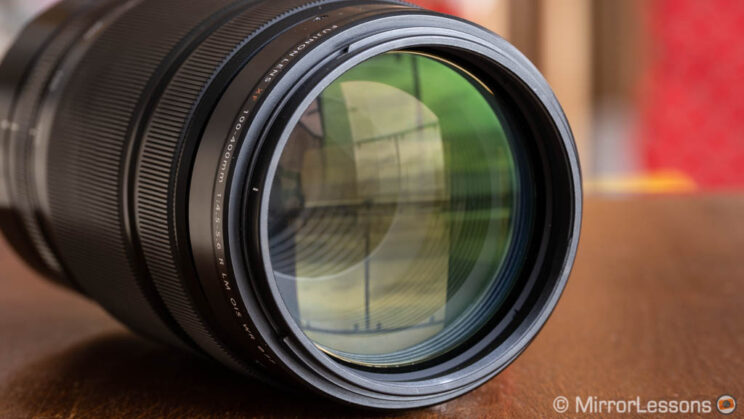
Both lenses feature rubber on the zoom and focus rings, which makes them nice to the touch.
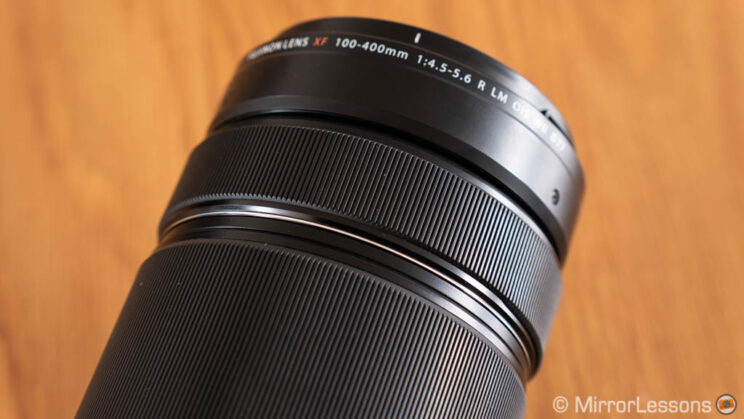
The zoom ring is smoother on the 100-400mm. That of the 70-300mm has more resistance when rotated, but not to a point of being uncomfortable. Both rings offer a small rotation arc, meaning that you can go very quickly from the shortest to the longest focal length.
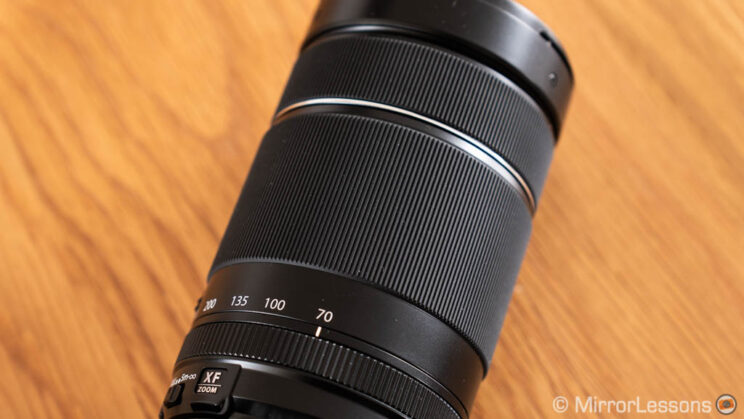
A lock switch is present on both lenses to prevent the zooms from extending when carried. Curiously, the locking mechanism of the 70-300mm is weak and you can simply turn the zoom ring to unlock it. I don’t know if this was intentional or not, but I find it quite handy because you don’t have to remember to unlock the zoom – just rotate the ring and start using the lens.
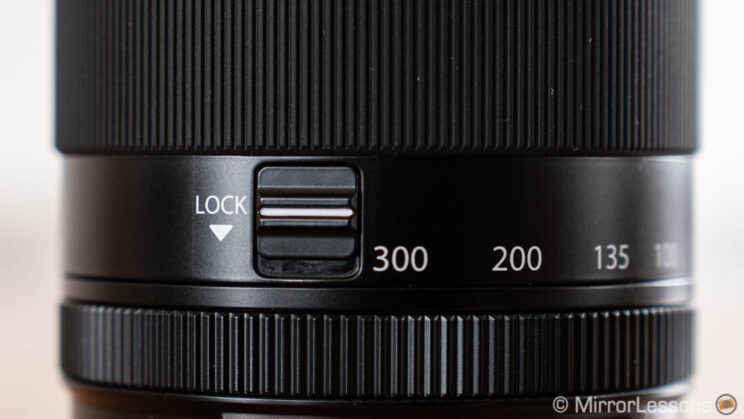
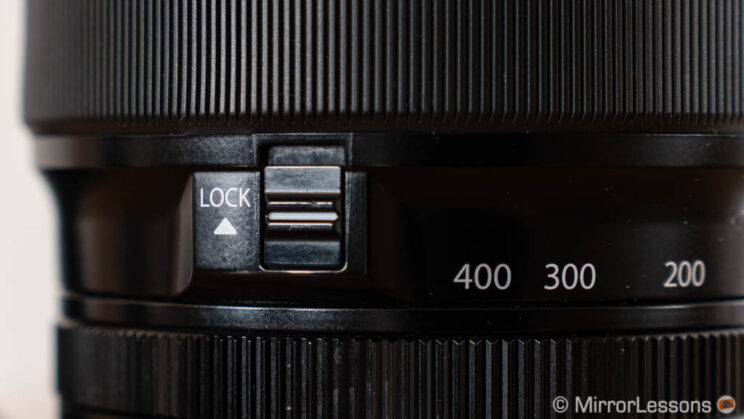
The aperture ring is smoother on the 70-300mm, but also feels a tad less precise, whereas you can clearly feel the stronger clicking mechanism on the 100-400mm as you rotate the ring.
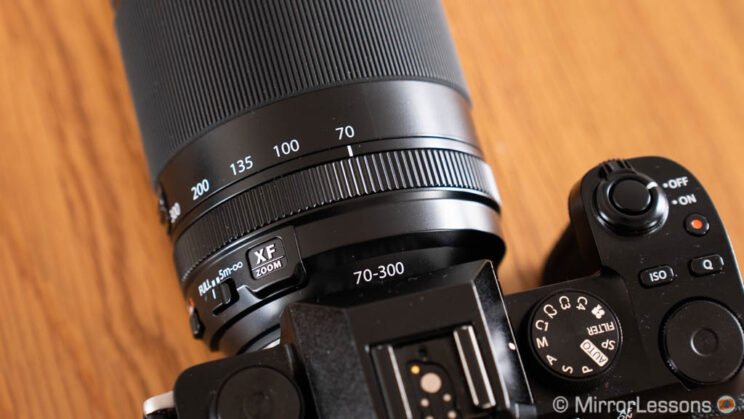
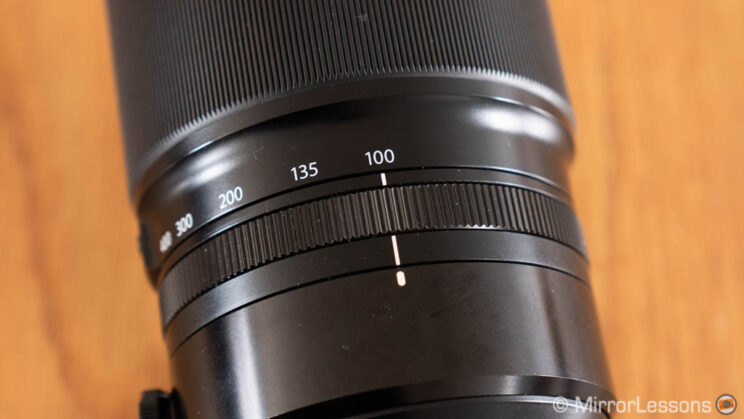
On the side, both lenses feature:
- a Focus Limiter switch (Full or 5m to infinity)
- an Auto / Manual Aperture switch
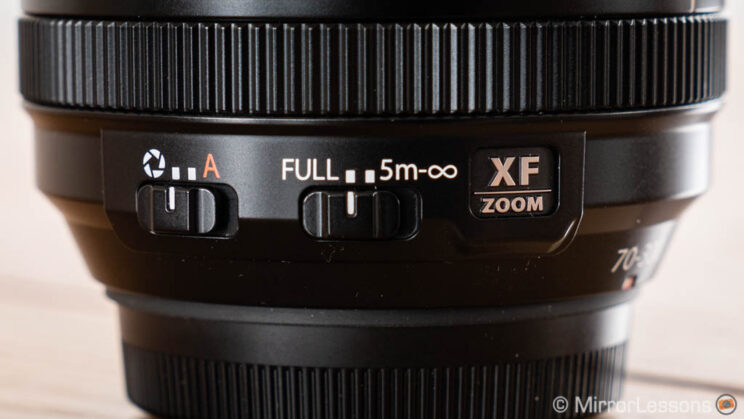
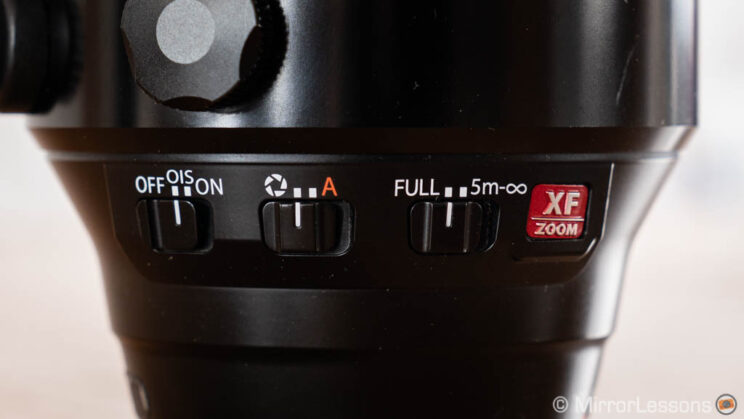
Note: on recent Fujifilm models such as the X-T4 and X-S10, you can choose between two additional focus limiter presets, or set one manually in the menu of the camera (AF Range Limiter). One of the two presets has the same 5m-to-infinity range of the lens’ switch, so not very useful. The custom mode is probably the most interesting option. It’s a shame you can’t recall these settings on the lenses itself, but you can assign the AF Range Limiter function to a custom button. If you plan to use this feature, make sure to leave the switch on the lens to ‘Full’.
The 100-400mm also features an OIS switch to quickly activate or deactivate optical stabilisation. On the 70-300mm lens, you need to perform this operation in the menu of the camera, which is less convenient. Here as well, the best workaround is to assign ‘IS Mode’ to a function button.
Because of the larger size, the 100-400mm comes with a tripod mount that can be rotated 360˚, or easily removed by loosening the two mounting screws. Note that the mount is not directly compatible with tripod heads such as Arca Swiss, so you’ll need to attach a compatible plate.
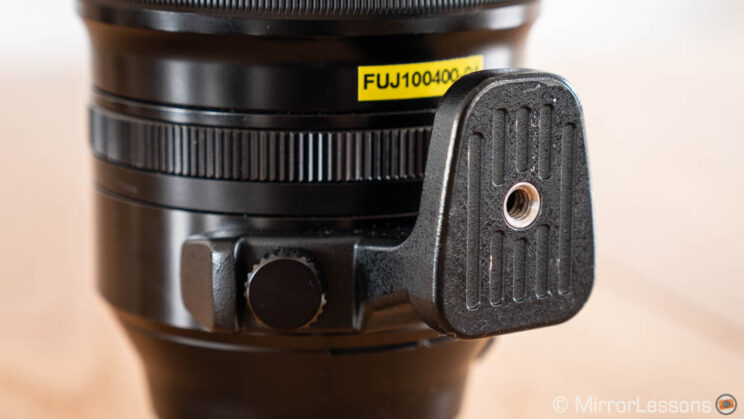
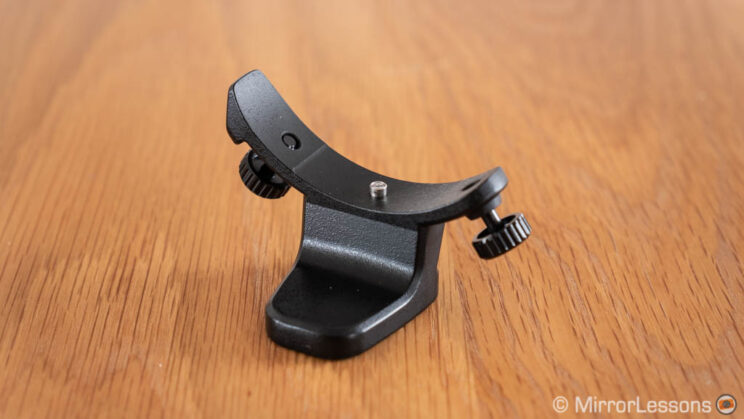
Finally, both lenses come with a plastic hood. That of the 100-400mm has a locking mechanism (you press the button to unlock it and remove it) and a window to rotate an optional polarising filter.
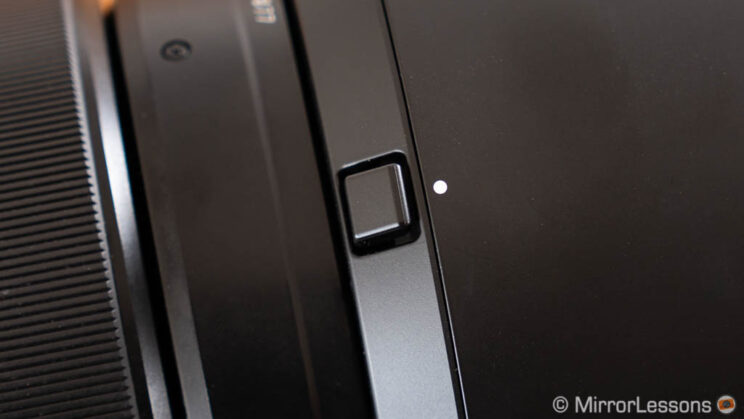
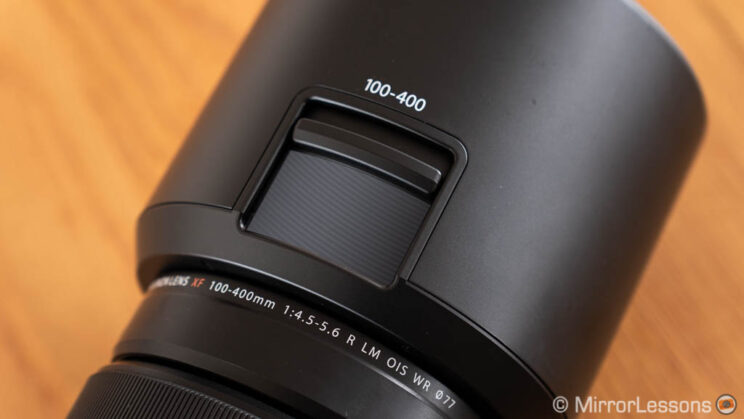
Field of View and Aperture
The two zooms, designed for Fujifilm’s APS-C sensor, have a different range:
- 70-300mm, which equals approximately 105-450mm on full frame / 35mm format (concerning the angle of view)
- 100-400mm, which corresponds to more or less 150-600mm on full frame
From the image below you can see the difference between 70mm and 100mm / 300mm and 400mm on the APS-C sensor.
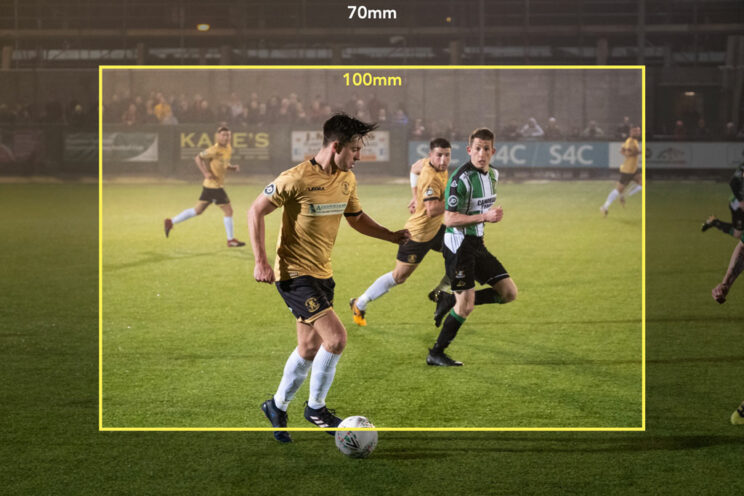
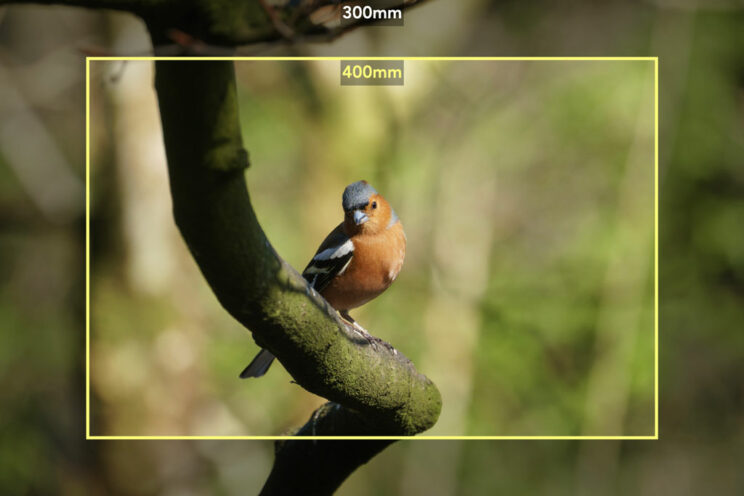
As for the variable fastest apertures, here is how the two lenses behave as you increase the focal length. It’s interesting to note how the 100-400mm offers many more aperture variations than the 70-300mm.
| XF 70-300mm | Fast. Aperture |
|---|---|
| 70-80mm | f/4.0 |
| 81-108mm | f/4.5 |
| 109-213mm | f/5.0 |
| 214-300mm | f/5.6 |
| XF 100-400mm | Fast. Aperture |
|---|---|
| 100-106mm | f/4.5 |
| 107-127mm | f/4.6 |
| 128-152mm | f/4.7 |
| 153-182mm | f/4.8 |
| 183-279mm | f/5.0 |
| 280-322mm | f/5.2 |
| 323-346mm | f/5.4 |
| 347-400mm | f/5.6 |
Optical Quality
Sharpness
Before analysing the images side by side, here is a recap of the two lenses’ key performance points.
Fujinon XF 70-300mm Key Takeaways:
- Excellent at the fastest apertures across the whole zoom range
- Peak sharpness is found at f/5.6 (70 to 100mm) and f/8 (200 to 300mm), but the difference at nearby apertures is small
- f/11 is good throughout the entire zoom range
- diffraction becomes visible at f/16 and severe at f/22 on the entire zoom range
Fujinon XF 100-400mm Key Takeaways:
- a bit weaker overall at the fastest apertures
- peak performance at f/8 and f/11, but 5.6 is close
- at 400mm, the results are a bit soft at f/5.6
- deals with diffraction better, f/16 is acceptable most of the time
As usual, to make the article easier to digest, I’m only showing the most important differences.
At 70mm, the 70-300mm peaks at f/5.6, but the results at f/4 and f/8 are excellent. The level remains good at f/11, whereas from f/16 diffraction starts to impact the quality. At f/22, the image is soft.
At 100mm, the 70-300mm has a small advantage at f/4.5. At f/5.6, f/8 and f/11, the results are very similar. At f/16, diffraction starts to decrease the quality and at f/22 both lenses deliver soft images, although the 100-400 does a bit better overall.
At 200mm, the 100-400mm has a small advantage at f/5.0 and f/5.6. At f/8, the difference is almost imperceptible. At f/11, the 100-400mm shows crisper results once again. The advantage remains at f/16 and f/22, although both lenses are affected by diffraction.
At 300mm and each lens’ fastest aperture, the level is very similar, whereas the 100-400mm has a slight edge at f/5.6. At f/8 and f/11, the quality is very similar. The same trend continues at f/16 and f/22.
Finally, at 400mm, the quality of the 100-400mm zoom is decent at f/5.6 but the lens gives the best result at f/8 and f/11. The level is acceptable at f/16 and soft at f/22.
Bokeh
It’s rare that lenses of this kind deliver an outstandingly smooth bokeh, but the two zooms don’t do too badly in this respect. They look pretty similar as you can see from the images below. The 70-300mm has slightly rounder bokeh balls, but the difference is difficult to detect.
Depending on the position of the subject, the distance from the background and / or the elements around it, the out of focus areas can appear a bit messier and more distracting. This is a characteristic I’ve seen on many lenses of this kind.
Other characteristics
There isn’t a lot left to say when it comes to optical quality. Neither lens shows any visible sign of chromatic aberration. Distortion, while certainly corrected in camera, is basically non-existent in the final result.
Both products show mild vignetting at the fastest aperture, and the shortest and longest focal length, but closing the aperture by 1 stop is enough to get rid of it.
Finally, you’ll need a pretty strong source of light entering the lenses directly to see invasive flares.
Autofocus and Manual Focus
The 70-300mm features one linear focus motor, whereas the 100-400mm has two linear motors to move the larger lens elements inside the barrel faster. Practically speaking, I didn’t find a substantial difference in performance.
In single AF, with static or slow moving subjects, both lenses focus fast and accurately, and it is up to the AF system of your Fujifilm camera to do the rest. I had no specific problems with small birds perched on a tree, or more distant animals, using the X-S10 and X-T4.
With birds in flight and my usual red kites test, the X-S10 and X-T4 gave me a very similar keeper rate with the 70-300mm, and the score matches the one I previously had when testing the X-T4 with the 100-400mm.
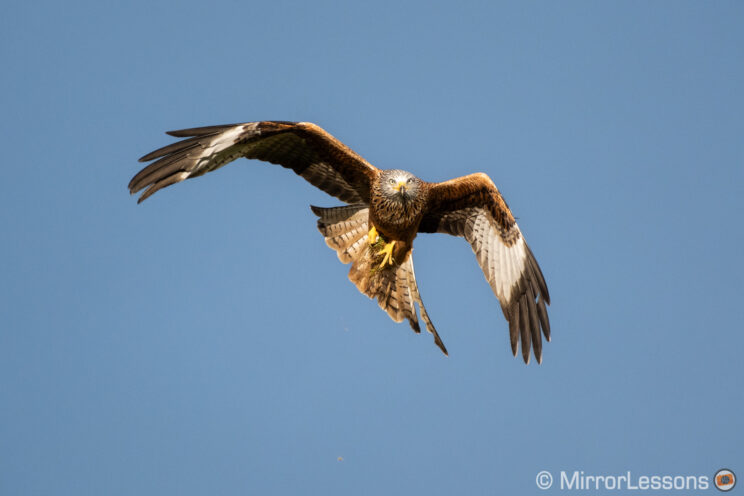
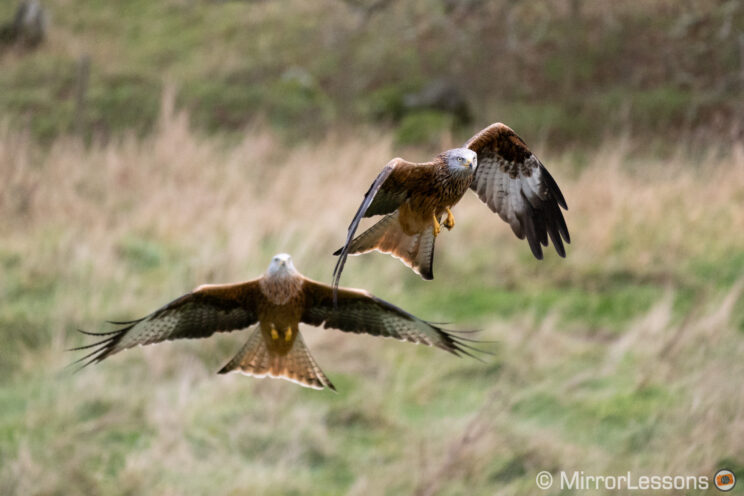
Here are the results I got with each lens and camera combination. Note that a small difference of 2% or 3% is not that relevant. Cameras and lenses were up to date concerning the firmware.
| X-S10 with 70-300mm | 78% | 94% |
| X-T4 with 70-300mm | 81% | 96% |
| X-T4 with 100-400mm | 79% | 94% |
The first number only includes images that are perfectly sharp, whereas the second number also includes slightly soft photos.
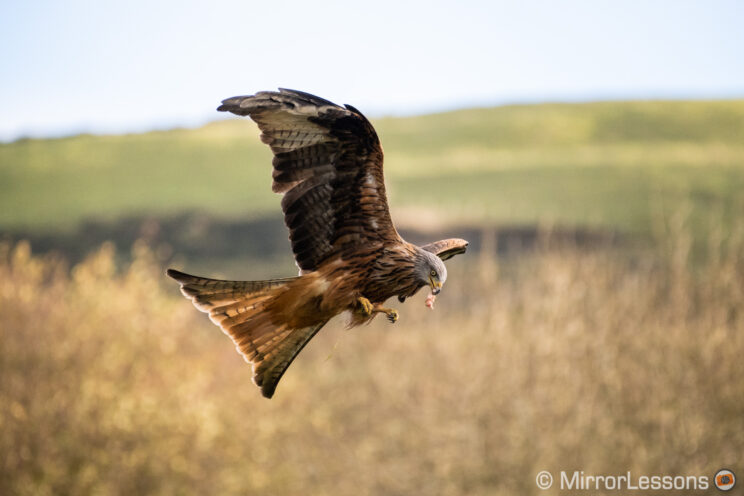
You can find out more about my birds in flight test, as well as the best settings to use for Fujifilm cameras, in the two articles below:
Concerning the minimum focus distance, the 70-300mm has more magnification possibilities and, at 300mm, you’re almost in semi-macro territory.
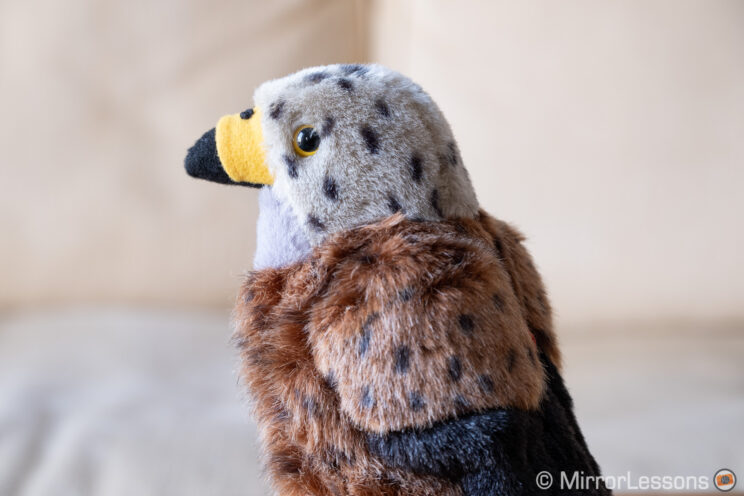
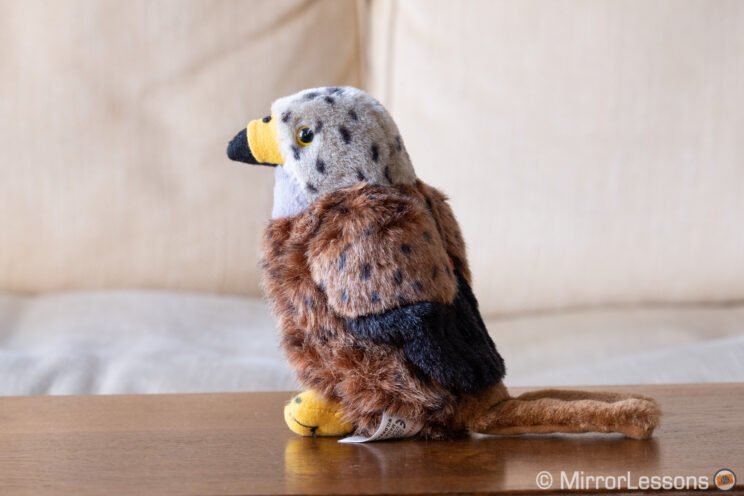
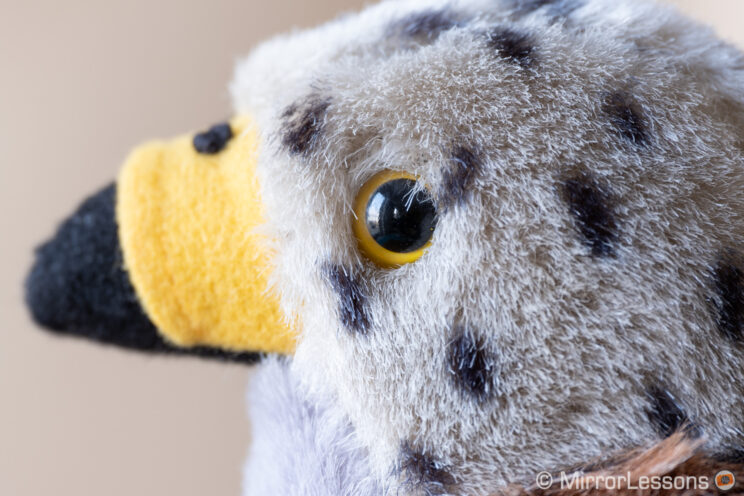
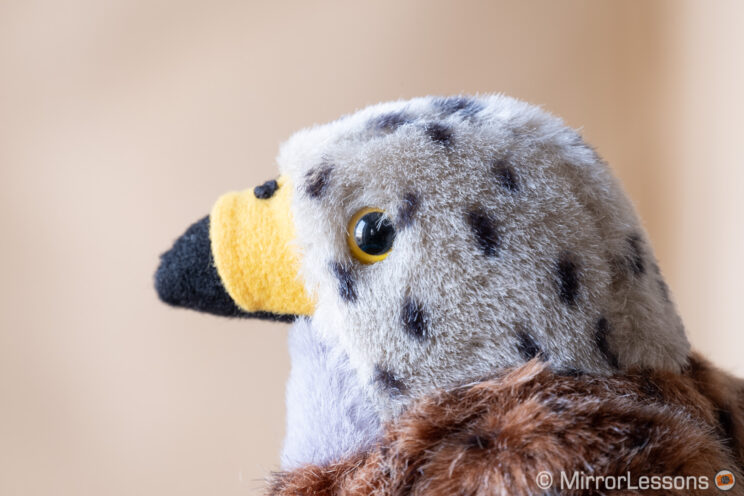
Concerning the manual focus experience, the fly-by-wire focus ring of the 100-400mm is smoother and more precise. That of the 70-300mm produces small jumps as you increase or decrease the focus distance (a problem I’ve seen with various Fujifilm lenses). It can be a bit more annoying if you need to nail focus very precisely.
Optical Stabilisation
The 70-300mm has a rating of 5.5 stops of compensation, whereas the 100-400mm is slightly behind at 5.0 stops of compensation.
However, when the 100-400mm is paired with the X-T4 or the X-S10 that feature in-body image stabilisation, the rating goes up to 5.5 stops. With the X-H1, on the other hand, it remains unchanged.
To see how far I could go using slow shutter speeds with the two lenses, I took 10 shots at different focal lengths and shutter speeds, and calculated the keeper rate for each.
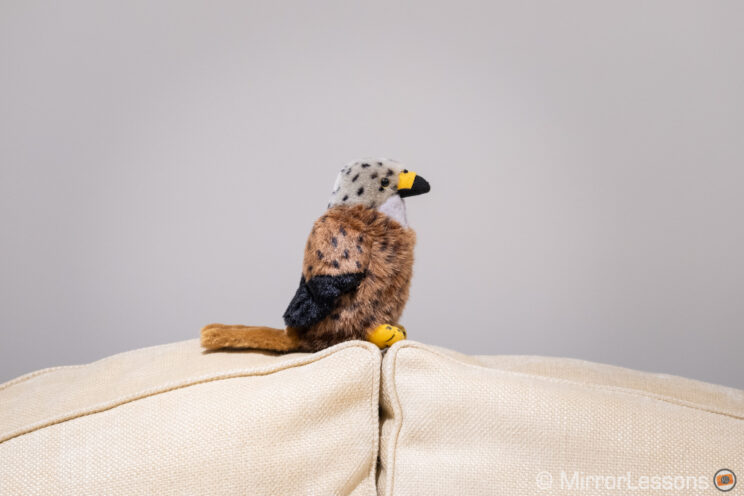
Here are the results (made with the X-T4).
| Shutter Speed | 70-300mm at 70mm | 100-400mm at 100mm |
|---|---|---|
| 1/2s | 10% | 0% |
| 1/4s | 10% | 0% |
| 1/8s | 40% | 10% |
| 1/15s | 80% | 80% |
| 1/30s | 100% | 100% |
| 1/60s | 100% | 100% |
| 1/125s | 100% | 100% |
| Shutter Speed | 70-300mm at 300mm | 100-400mm at 300mm | 100-400mm at 400mm |
|---|---|---|---|
| 1/2s | 0% | 0% | 0% |
| 1/4s | 0% | 0% | 0% |
| 1/8s | 10% | 0% | 0% |
| 1/15s | 10% | 10% | 0% |
| 1/30s | 40% | 40% | 20% |
| 1/60s | 60% | 60% | 60% |
| 1/125s | 90% | 90% | 100% |
In short, you need to stay above 1/8s at 70mm, or 1/30s at 300mm to have a good keeper rate when using the 70-300mm.
With the 100-400mm, forget anything slower than 1/15s and, when shooting at 300mm and 400mm, you need to work at 1/60s or faster to have a decent keeper rate.
The lenses and cameras do not allow you to choose settings according to your movements, like for example, compensating only vertically while panning horizontally. However, according to Fujifilm, the 100-400mm can automatically detect the type of movement the photographer makes, and compensate accordingly.
I couldn’t find the same information for the 70-300mm so I assume it doesn’t behave in the same way.
Indeed, during my birds in flight test, I found a few images with motion blur when using the 70-300mm with OIS activated. To be fair, there were only a few photos out of the thousands I captured, and it happened when the bird suddenly changed direction and I abruptly changed my movement to keep following it.
Otherwise, leaving the stabilisation on didn’t gave me any problems with either lenses. That said, for erratic and unpredictable subjects, it is better to use a safe shutter speed and to leave OIS off, especially on the smaller lens.
In the 70-300mm manual, Fujifilm states that the optical stabilisation helps to reduce the blur caused by the movement of the mechanical shutter, and therefore the company suggests leaving it on even when working are on a tripod.
I tested this as well and I didn’t find any difference when leaving the stabilisation on or off with the gear mounted on my tripod (both the 70-300mm and 100-400mm), at least on the X-T4 and X-S10. Perhaps this tip can be more useful for older Fujifilm cameras that have a less subtle shutter mechanism.
Teleconverters
Both lenses are compatible with the XF 1.4x and XF 2.0x teleconverters. Here are the range and apertures you get with the two lenses.
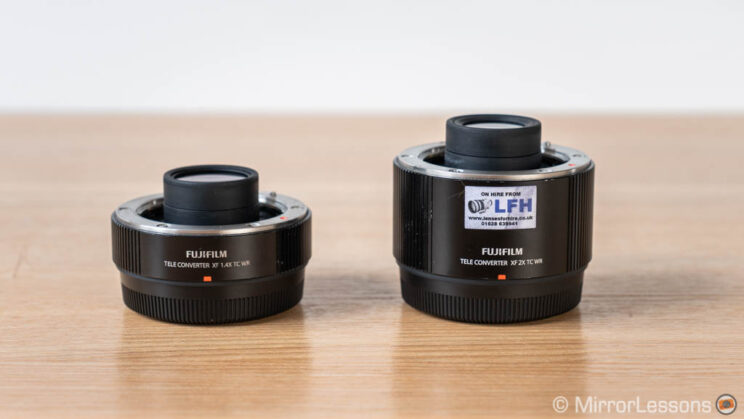
| Lens | TC 1.4x | TC 2.0x |
|---|---|---|
| 70-300mm F4-5.6 | 98-420mm F5.6-8 (147-630mm eq.) | 140-600mm F8-11 (210-900mm eq.) |
| 100-400mm F4.5-5.6 | 140-560mm F6.3-8 (210-840mm eq.) | 200-800mm F9-11 (300-1200mm eq.) |
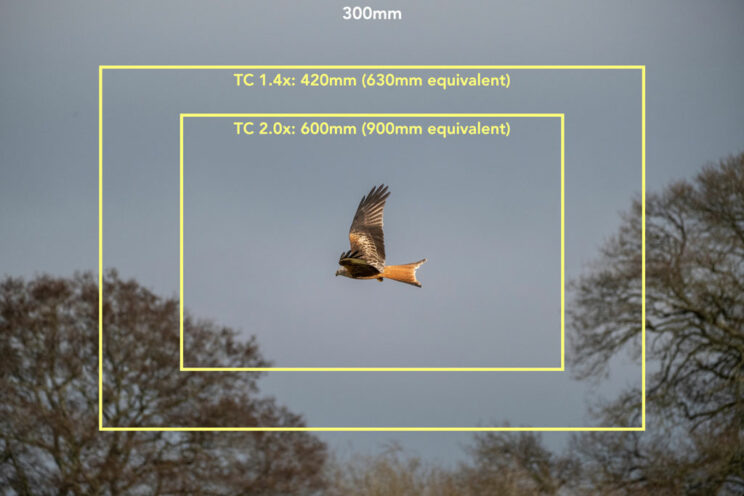
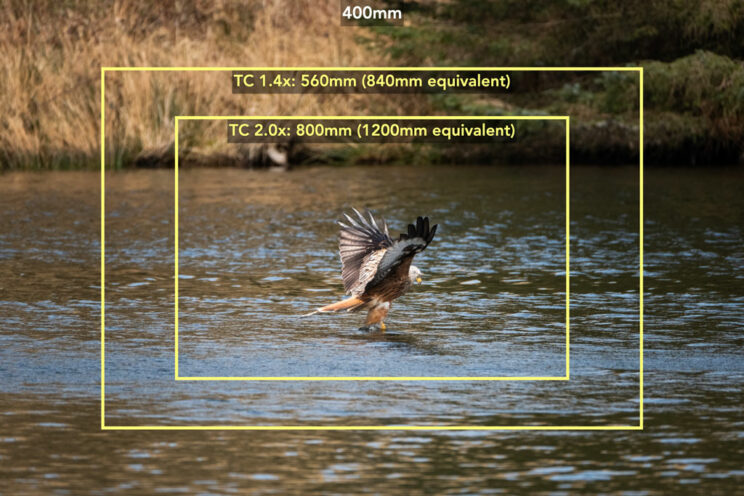
On the 70-300mm, the 1.4x TC retains a good level of sharpness at f/8 and f/11. Results are decent at f/16 but softer from f/22, as expected.
The TC 2.0x decreases the quality a little, but the image looks good at f/11 and decent at f/16. From f/22, diffraction is more visible once again.
On the 100-400mm, the best performance is found at f/11 and f/16 for the 1.4x TC, and f/16 and f/22 for the TC 2.0x.
I found that the autofocus performance slowed down a bit, especially for birds in flight. At times the cameras took more time to refocus properly, especially with the TC 2.0x. To be fair though, by the time I started using the teleconverters, the light got worse. We were hit with various storms during the two weeks of testing, so I didn’t have more opportunities to test the gear in better conditions.
Prices
The 70-300mm comes at the very attractive price of $800, £730 or €800.
The 100-400mm is much more expensive with retail prices of $1900, £1550 or €1700.
The teleconverters cost, respectively:
- TC 1.4x: $450, £370 or €410
- TC 2.0x: $450, £390 or €430
Note: prices are as of January 2022 and exclude special promotions or temporary rebates. Euro prices can vary from country to country.
About the cameras
Before the conclusion, I want to share a few words about the two main cameras I used to produce this article.
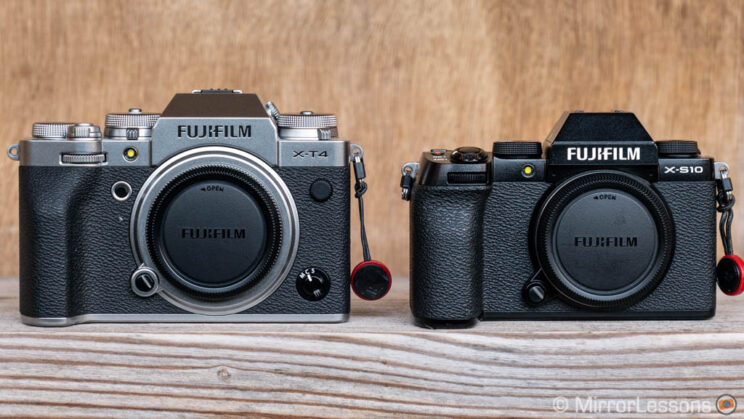
The X-T4 and X-S10 have the same 26MP sensor, same autofocus system, and same continuous shooting speed, so when it comes to quality and performance, they behave in the same way.
The X-S10’s main strength is the larger grip at the front, and given the small dimensions, when paired with the 70-300mm, it becomes a nice compact set-up for wildlife and bird photography. Plus, both the camera and the lens are have a very competitive price.
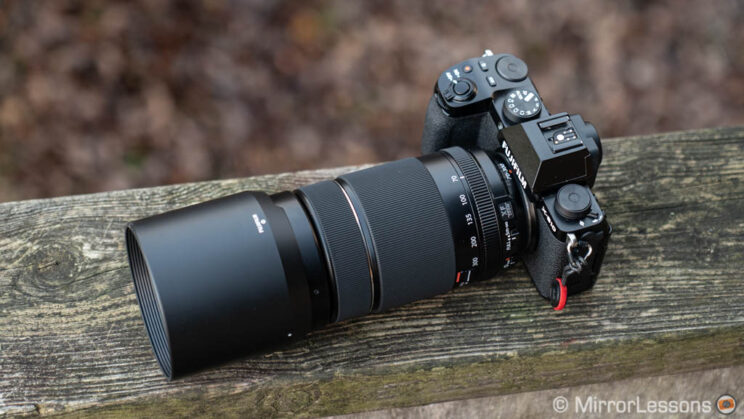
The EVF is good but only average by today standards (I find it a bit small personally) and I’m not crazy about the ergonomics of the camera. Some buttons are really small, and the AF joystick can lack precision. Also, the X-S10 is not weather sealed.
The X-T4 feels more solid, has more buttons and dials, including the classic shutter speed dial that has been a signature of Fujifilm cameras since the beginning. It has a larger EVF with more resolution, and overall I find the controls better positioned and more satisfying to use.
The X-T4 is weather sealed and has a larger battery that lasts for longer in comparison to that of the X-S10. It also has two SD card slots with a dedicated compartment on the side, unlike the X-S10 on which you have to access the card from the battery compartment.
As for the negative points, it’s mainly the lack of a more prominent grip that makes the X-T4 less comfortable to use with large lenses such as the 100-400mm. It is also more expensive than the X-S10.
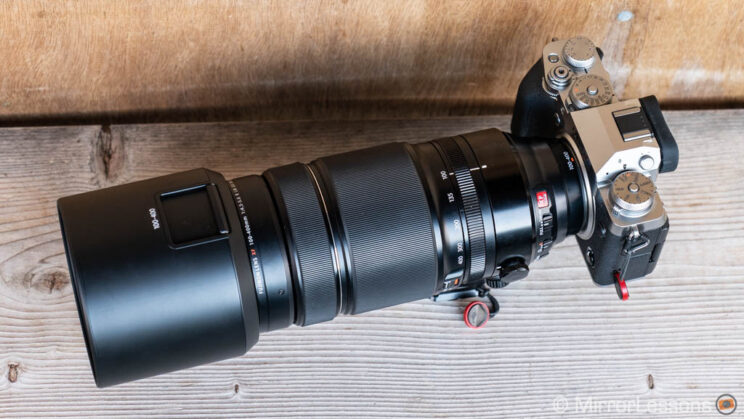
Reminder: the links below are affiliate links. If you decided to buy something after clicking the link, we will receive a small commission.
Check price of the Fujifilm X-T4 on
Amazon | Amazon UK | B&H Photo | eBay
Check price of the Fujifilm X-S10 on
Amazon | B&H Photo | eBay
Video Review
The video version of this article is available below and on our YouTube channel.
Conclusion
There are other lenses in the Fujifilm X-series that are part of the long telephoto lens category. We have the older 55-200mm and 50-230mm, with less reach and no teleconverter compatibility, and the superb but very expensive 200mm F2. A new 150-600mm is also in development, which means that Fujifilm really believes there is a place for its APS-C cameras in the wildlife and bird photography market.
For now though, the 70-300mm and the 100-400mm are the two most interesting options you can find because they offer the most flexibility when it comes to zoom range, performance and price.
Is there a clear winner between the two? Well, I must admit that the 70-300mm ticks all the boxes. Optically, it is at the same level as the 100-400mm, and the autofocus performance is spot on. You also get better close-up capabilities and Fujifilm was smart to make the lens compatible with the two teleconverters.
Some of you might not like the use of plastic for the construction, but the advantage is a much lighter (and smaller) lens, and it still comes with weather-sealing for a much lower price.
The 100-400mm is a lens I know better because I’ve tested it many times since it came out in 2016, and not just for birds but also football and rallies. It never disappointed me. Granted, it is bigger, but it offers a longer reach at the telephoto end, feels more robust, and has a few extra features such as the OIS switch and the filter window on the hood.
That said, with the arrival of the 70-300mm, you now need to look at the details to decide if double the price and weight is justified. And I suspect that many photographers will be totally happy with the smaller lens.
Reminder: the links below are affiliate links. If you decided to buy something after clicking the link, we will receive a small commission.
Check price of the Fujinon 70-300mm on
Amazon | B&H Photo | eBay
Check price of the Fujinon 100-400mm on
Amazon | Amazon UK | B&H Photo | eBay
Check price of the Fujifilm XF TC 1.4x on
Amazon | Amazon UK | B&H Photo | eBay
Check price of the Fujifilm XF TC 2.0x on
Amazon | B&H Photo | eBay

